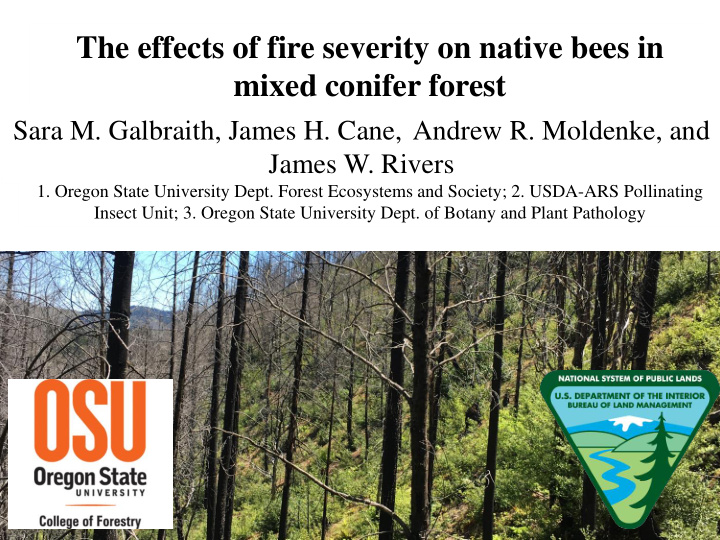



The effects of fire severity on native bees in mixed conifer forest Sara M. Galbraith, James H. Cane, Andrew R. Moldenke, and James W. Rivers 1. Oregon State University Dept. Forest Ecosystems and Society; 2. USDA-ARS Pollinating Insect Unit; 3. Oregon State University Dept. of Botany and Plant Pathology
Animal pollinators play an essential role in forest ecosystems
Little known about native bees in dynamic forest ecosystems How does fire severity influence native bee communities in mixed-conifer forest?
Study took place in Southwestern Oregon where the Douglas Complex fire burned in 2013
Selected 35 stands spanning fire severity gradient 1200 1000 Fire severity (RdNBR) 800 600 400 Low (1-25%) Moderate Low (26-50%) 200 Moderate High (51-75%) 0 High (76%+)
Sampled bee communities and habitat variables during spring/summer 2016 and 2017 Four sampling periods/year: May-September 2016 May-September 2017
Collected 5,170 bees representing 26 genera and 109 morphospecies
The number of bees collected per stand increased with fire severity
The number of bee species collected per stand also increased with fire severity
Canopy cover decreased and flowering plant density increased with fire severity Low High
How is bee reproductive output influenced by fire severity? 20 female, 25 male cocoons 2 blocks/stand Photo: USDA-ARS
X-rayed blocks in the fall to assess number of successful offspring, sex ratio
Nests had more offspring and females when fire severity was higher within 1000m from nest block Pollen grains Nesting block nearly filled sampled from nest with offspring block
In summary…. • The number of bees and number of bee species increases with fire severity • Reproductive output of a native bee increases with fire severity within 1km of the nest
Many thanks to… Funding and in-kind support: FWHMF program, Oregon State University; Bureau of Land Management; Mealey/ Boise Cascade/ Boone and Crockett/Noble Endowment Fund from the College of Forestry, Oregon State University Seven Oaks Nursery; Brushy Mountain Bee Farm Logistical support: George McFadden, Bruce Hollen, Chris Dunn, Michael Hoe, Andy Moldenke, Jim Brimble, Rachel Showalter, Gabriela Ritokova, Byron Love Field and lab crew: Ian Lively, Kasia Szczurek, Nicole Scavo, Sydney Watkins, Lisa Zander, Mariel King
Bees are some of the most important pollinators, Photos: Lisa Zander, Sharp Photography
Study location: Mixed-conifer forest in Southwestern Oregon (Klamath Mountains)
Recommend
More recommend